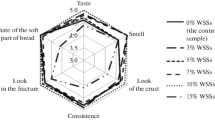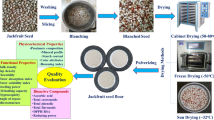Abstract
The by-product of walnut oil (Juglans regia L.) extraction is a press cake rich in polyunsaturated fatty acids and other bioactive compounds. From this cake, walnut flour is obtained by a milling process. The composition and a physicochemical characterization of walnut flour was performed: proximal composition, mineral content, and fatty acid and amino acid profiles were measured. Besides, antioxidant capacity and water and oil holding capacities were determined. Walnut flour has 55% of lipids with an optimum w6/w3 ratio, a good lysine/arginine ratio, and high levels of antioxidants that contribute to its oxidative stability, the estimated shelf life being 16 months. In regards to interaction with other ingredients, walnut flour retained 258 and 70% (w/w) of water and oil, respectively. Therefore, these results show that walnut flour is a good source of micro- and macronutrients, compared to flours commonly used in breadmaking. Also, walnut flour has good technofunctional properties and thus its incorporation could improve the nutritional and technological characteristics of new bakery products.


Similar content being viewed by others
Data Availability
The data that support the findings of this study are available from the corresponding author, upon reasonable request.
Abbreviations
- ABTS:
-
[2,2′-Azino-bis(3-ethylbenzothiazoline-6-sulphonic acid)]
- Cys:
-
Cysteine
- DPPH:
-
2,2-Diphenyl-1-picrylhydrazyl
- EAA:
-
Essential amino acids
- ESEM:
-
Environmental scanning electron microscope
- FRAP:
-
Ferric reducing antioxidant power
- GAE:
-
Gallic acid equivalents
- IC50 :
-
Half maximal inhibitory concentration
- Met:
-
Methionine
- MUFA:
-
Monounsaturated fatty acids
- Phe:
-
Phenylalanine
- PUFA:
-
Polyunsaturated fatty acids
- RNI:
-
Recommended nutrient intake
- SFA:
-
Saturated fatty acids
- TEAC:
-
Trolox equivalents
- Tyr:
-
Tyrosine
- WF:
-
Walnut flour
References
Schieber A, Stintzing FC, Carle R (2001) By-products of plant food processing as a source of functional compounds — recent developments. Trends Food Sci Technol 12:401–413. https://doi.org/10.1016/S0924-2244(02)00012-2
Labuckas D, Maestri D, Lamarque A (2014) Effect of different oil extraction methods on proximate composition and protein characteristics of walnut (Juglans regia L.) flour. LWT - Food Sci Technol 59:794–799. https://doi.org/10.1016/j.lwt.2014.06.038
Mao X, Hua Y (2012) Composition, structure and functional properties of protein concentrates and isolates produced from walnut (Juglans regia L.). Int J Mol Sci 13:1561–1581. https://doi.org/10.3390/ijms13021561
Martins ZE, Pinho O, Ferreira IMPLVO (2017) Food industry by-products used as functional ingredients of bakery products. Trends Food Sci Technol 67:106–128. https://doi.org/10.1016/j.tifs.2017.07.003
Troise AD, Wilkin JD, Fiore A (2018) Impact of rapeseed press-cake on Maillard reaction in a cookie model system. Food Chem 243:365–372. https://doi.org/10.1016/j.foodchem.2017.09.153
Jukić M, Lukinac J, Čuljak J et al (2019) Quality evaluation of biscuits produced from composite blends of pumpkin seed oil press cake and wheat flour. Int J Food Sci Technol 54:602–609. https://doi.org/10.1111/ijfs.13838
Aranibar C, Aguirre A, Borneo R (2019) Utilization of a by-product of chia oil extraction as a potential source for value addition in wheat muffins. J Food Sci Technol 56:4189–4197. https://doi.org/10.1007/s13197-019-03889-1
Bakkalbasi E, Meral R, Dogan IS (2015) Bioactive compounds, physical and sensory properties of cake made with walnut press-cake. J Food Qual 38:422–430. https://doi.org/10.1111/jfq.12169
Pycia K, Kapusta I, Jaworska G (2020) Walnut oil and oilcake affect selected the physicochemical and antioxidant properties of wheat bread enriched with them. J Food Process Preserv 44:e14573. https://doi.org/10.1111/jfpp.14573
Pop A, Păucean A, Socaci SA, et al (2020) Quality characteristics and volatile profile of macarons modified with walnut oilcake by-product. Molecules 25:2214. https://doi.org/10.3390/molecules25092214
WHO (2005) Vitamin and mineral requirements in human nutrition, 2nd ed. World Health Organization
Hager A-S, Wolter A, Jacob F et al (2012) Nutritional properties and ultra-structure of commercial gluten free flours from different botanical sources compared to wheat flours. J Cereal Sci 56:239–247. https://doi.org/10.1016/j.jcs.2012.06.005
Wang J, Chatzidimitriou E, Wood L, et al (2020) Effect of wheat species (Triticum aestivum vs T. spelta), farming system (organic vs conventional) and flour type (wholegrain vs white) on composition of wheat flour – Results of a retail survey in the UK and Germany – 2. Antioxidant activity, and phenolic and mineral content. Food Chem X 6:100091. https://doi.org/10.1016/j.fochx.2020.100091
Laroche M, Bergeron J, Barbaro-Forleo G (2001) Targeting consumers who are willing to pay more for environmentally friendly products. J Consum Mark 18:503–520. https://doi.org/10.1108/EUM0000000006155
Salcedo CL, López de Mishima BA, Nazareno MA (2010) Walnuts and almonds as model systems of foods constituted by oxidisable, pro-oxidant and antioxidant factors. Food Res Int 43:1187–1197. https://doi.org/10.1016/j.foodres.2010.02.016
Labuckas DO, Maestri DM, Perelló M et al (2008) Phenolics from walnut (Juglans regia L.) kernels: antioxidant activity and interactions with proteins. Food Chem 107:607–612. https://doi.org/10.1016/j.foodchem.2007.08.051
Santos J, Alvarez-Ortí M, Sena-Moreno E et al (2018) Effect of roasting conditions on the composition and antioxidant properties of defatted walnut flour. J Sci Food Agric 98:1813–1820. https://doi.org/10.1002/jsfa.8657
Slatnar A, Mikulic-Petkovsek M, Stampar F et al (2015) Identification and quantification of phenolic compounds in kernels, oil and bagasse pellets of common walnut (Juglans regia L.). Food Res Int 67:255–263. https://doi.org/10.1016/j.foodres.2014.11.016
Pycia, Kapusta I, Jaworska (2019) Impact of the degree of maturity of walnuts (Juglans regia L.) and their variety on the antioxidant potential and the content of tocopherols and polyphenols. Molecules 24:2936–2936. https://doi.org/10.3390/molecules24162936
Arranz S, Pérez-Jiménez J, Saura-Calixto F (2008) Antioxidant capacity of walnut (Juglans regia L.): contribution of oil and defatted matter. Eur Food Res Technol 227:425–431. https://doi.org/10.1007/s00217-007-0737-2
Tapia MI, Sánchez-Morgado JR, García-Parra J et al (2013) Comparative study of the nutritional and bioactive compounds content of four walnut (Juglans regia L.) cultivars. J Food Compos Anal 31:232–237. https://doi.org/10.1016/j.jfca.2013.06.004
Costantini L, Lukšič L, Molinari R et al (2014) Development of gluten-free bread using tartary buckwheat and chia flour rich in flavonoids and omega-3 fatty acids as ingredients. Food Chem 165:232–240. https://doi.org/10.1016/j.foodchem.2014.05.095
Paciulli M, Rinaldi M, Cavazza A et al (2018) Effect of chestnut flour supplementation on physico-chemical properties and oxidative stability of gluten-free biscuits during storage. LWT 98:451–457. https://doi.org/10.1016/j.lwt.2018.09.002
WHO (2007) Protein and amino acid requirements in human nutrition: report of a joint FAO/WHO/UNU expert consultation. World Health Organization, technical report series, no 935
Morris CR, Hamilton-Reeves J, Martindale RG et al (2017) Acquired amino acid deficiencies: a focus on arginine and glutamine. Nutr Clin Pract 32:30S-47S. https://doi.org/10.1177/0884533617691250
Feldman EB (2002) The scientific evidence for a beneficial health relationship between walnuts and coronary heart disease. J Nutr 132:1062S-1101S. https://doi.org/10.1093/jn/132.5.1062S
Rabadán A, Pardo JE, Gómez R, Álvarez-Ortí M (2018) Evaluation of physical parameters of walnut and walnut products obtained by cold pressing. LWT- Food Sci Technol 91:308–314. https://doi.org/10.1016/j.lwt.2018.01.061
Fernández-López J, Lucas-González R, Viuda-Martos M et al (2018) Chia oil extraction coproduct as a potential new ingredient for the food industry: chemical, physicochemical, techno-functional and antioxidant properties. Plant Foods Hum Nutr 73:130–136. https://doi.org/10.1007/s11130-018-0670-5
Alfredo VO, Gabriel R-R, Luis C-G, Davi B-A (2009) Physicochemical properties of a fibrous fraction from chia (Salvia hispanica L.). LWT - Food Sci Technol 42:168–173. https://doi.org/10.1016/j.lwt.2008.05.012
Mora YN, Contreras JC, Aguilar CN et al (2013) Chemical composition and functional properties from different sources of dietary fiber. Am J Food Nutr 1:27–33. https://doi.org/10.12691/ajfn-1-3-2
Arp CG, Correa MJ, Ferrero C (2018) Rheological and microstructural characterization of wheat dough formulated with high levels of resistant starch. Food Bioproc Technol 11:1149–1163. https://doi.org/10.1007/s11947-018-2083-8
Dourado F, Barros A, Mota M et al (2004) Anatomy and cell wall polysaccharides of almond (Prunus dulcis D. A. Webb) seeds. J Agric Food Chem 52:1364–1370. https://doi.org/10.1021/jf030061r
Acknowledgements
To the UNLP (X661 and X771) and MINCYT (PICT 2014-3421, PICT 2015-0007 and PICT 2016-3047) for the financial support. Authors also want to thank the kind cooperation of Mariana Pennisi, Claudio Reyes, and Darío Cabezas in gas and liquid chromatography, and particle size measurements, respectively.
Author information
Authors and Affiliations
Corresponding author
Ethics declarations
Conflict of Interest
The authors declare that they have no conflict of interest.
Additional information
Publisher’s Note
Springer Nature remains neutral with regard to jurisdictional claims in published maps and institutional affiliations.
Supplementary Information
Below is the link to the electronic supplementary material.
ESM 1
(PDF 260 kb)
Rights and permissions
About this article
Cite this article
Burbano, J.J., Correa, M.J. Composition and Physicochemical Characterization of Walnut Flour, a By-product of Oil Extraction. Plant Foods Hum Nutr 76, 233–239 (2021). https://doi.org/10.1007/s11130-021-00898-4
Accepted:
Published:
Issue Date:
DOI: https://doi.org/10.1007/s11130-021-00898-4




